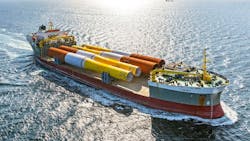Ørsted narrows offshore wind focus to contain costs
Offshore staff
FREDERICIA, Denmark — Ørsted’s board has approved a business plan that targets 35-38 GW of installed renewable energy capacity by 2030, down from its previously declared target of 50 GW.
Last year the company disclosed significant impairments and additional costs for terminating contracts related to certain US offshore wind projects. In response, the company has taken steps to strengthen its balance sheet to support long-term growth and capital structure resilience through 2030.
It has also undertaken a review of its project portfolio and decided on further measures to reduce risks.
The company stresses that its fundamental strategic choices on technologies and operating regions are unchanged, and it still aims to be the world leader in offshore and a regional player in onshore and Power-to-X (P2X) in Europe and the US.
Ørsted is incorporating lessons learned from its US offshore projects into its operating model to limit risks in the development and execution of projects. Contingency planning, monitoring of suppliers, inflation protection, scrutiny of pre-FID commitments, and greater flexibility on project timelines and commissioning dates are all areas of focus, along with project governance and reviews.
The company has ceased development of the Ocean Wind 1 and Ocean Wind 2 offshore wind projects in the form that was awarded by the New Jersey Board of Public Utilities, and the company will re-position the Skipjack Wind project to steer its US offshore portfolio toward the Northeast Atlantic.
To cut development costs and in line with its new focus, the company is also exiting offshore markets in Norway, Spain and Portugal, de-prioritizing development activities in Japan, and working on a leaner development model for floating offshore wind and P2X.
Following these changes, the company anticipates DKK3 billion ($433 million) of development expenditure reductions in 2024-2026 compared to numbers presented last June at the Capital Markets Day event.
Farm-downs and divestments should reduce costs by about DKK70 billion to DKK80 billion ($10.10 billion to $11.55 billion) in 2024-2026.
In the UK, the company’s Stromar Offshore Wind Farm joint venture with BlueFloat Energy and Renantis has submitted EIA scoping and HRA screening reports to the Marine Directorate and Aberdeenshire Council for the 1-GW floating offshore wind development.
Stromar is 50 km east of Wick in the central UK North Sea.
The HRA reports outline the main protected sites and species of relevance to the Stromar development area, and it addresses how potential impacts will be assessed in more detail at the next stage.
02.07.2024
